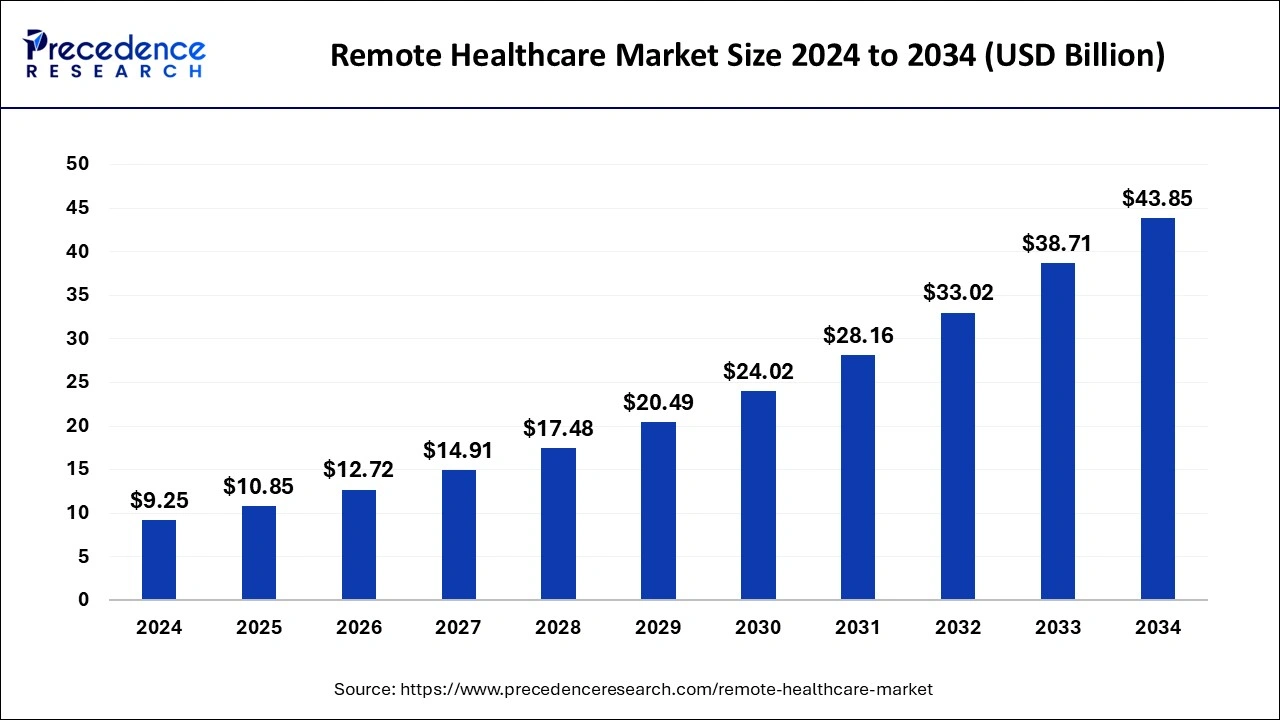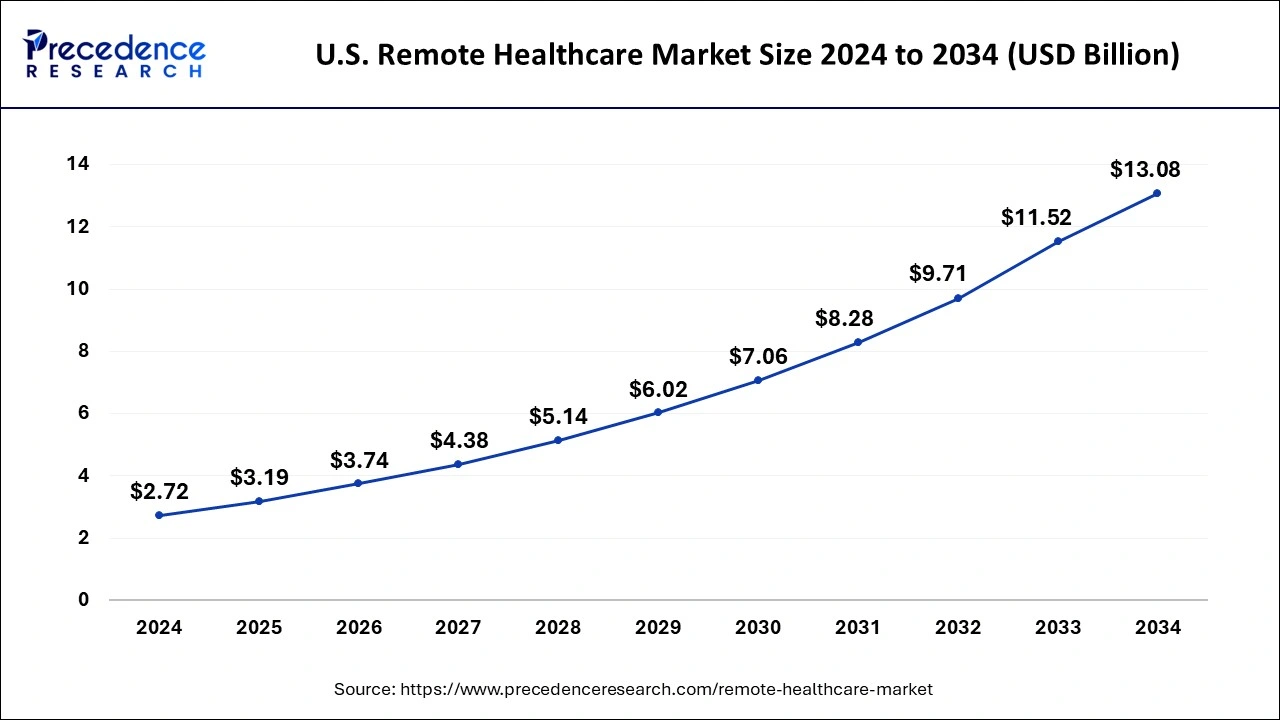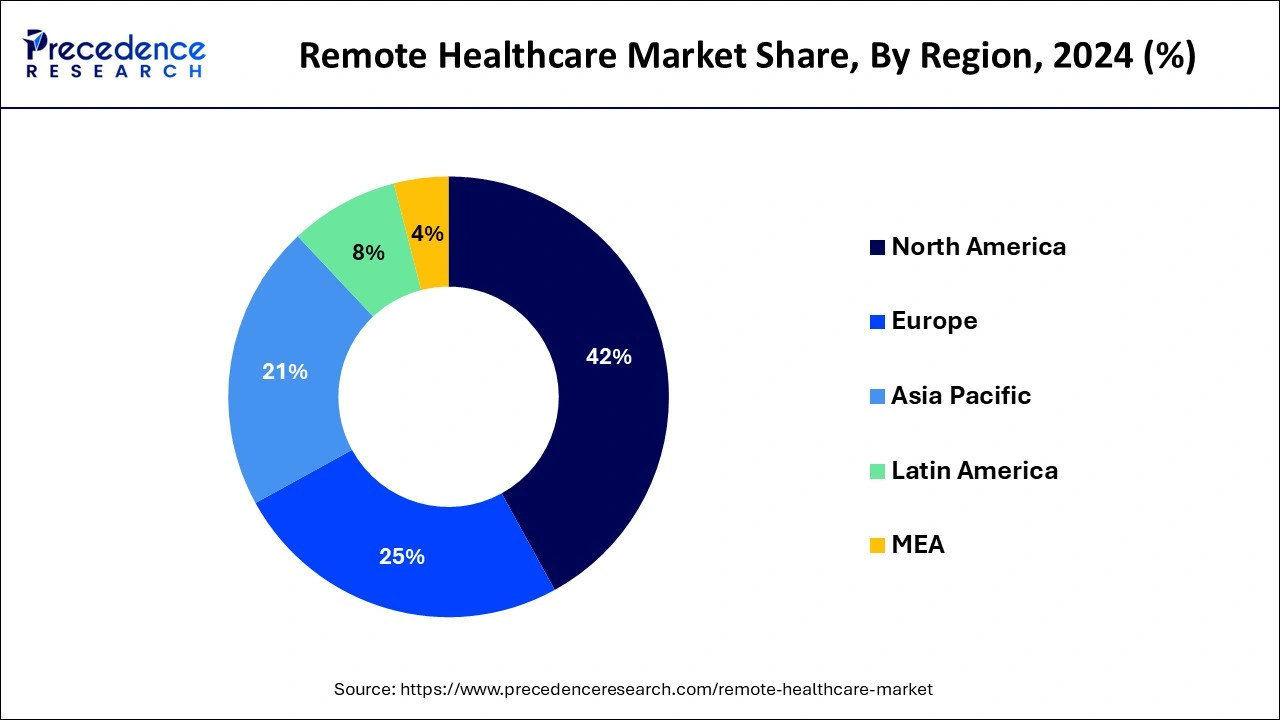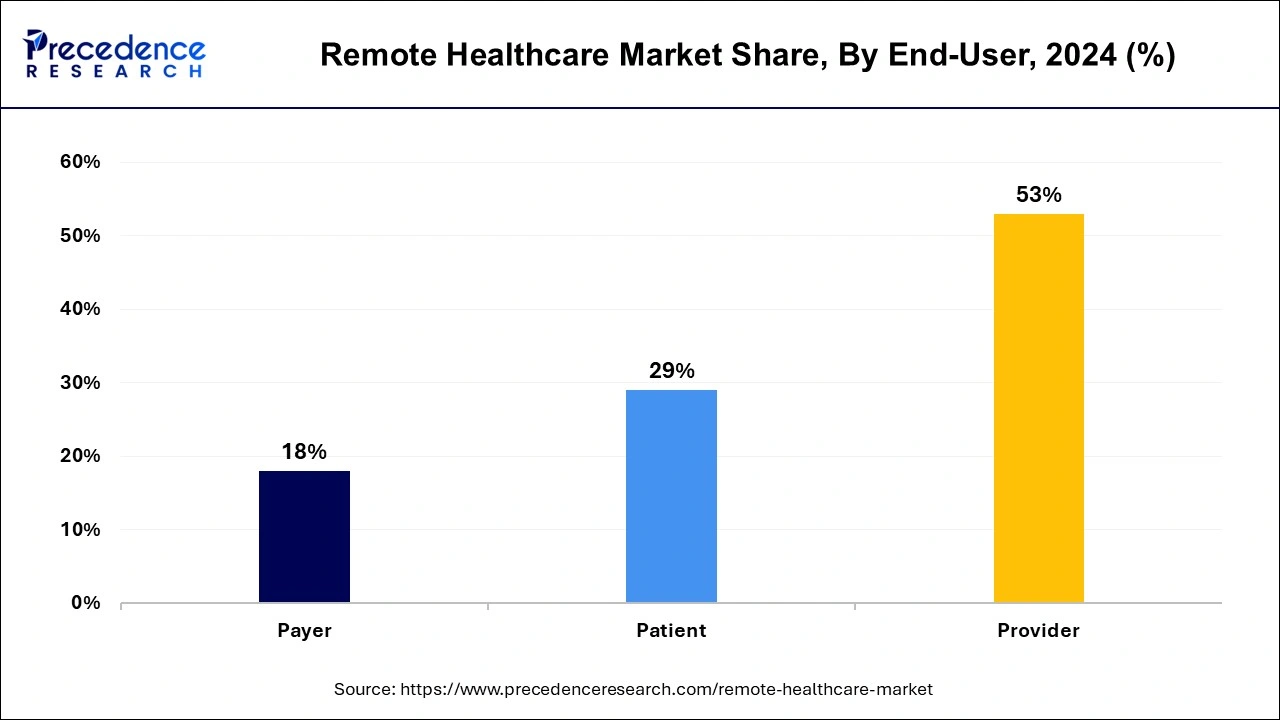Remote Healthcare Market Size and Forecast 2025 to 2034
The global remote healthcare market size was estimated at USD 9.25 billion in 2024 and is predicted to increase from USD 10.85 billion in 2025 to approximately USD 43.85 billion by 2034, expanding at a CAGR of 16.84% from 2025 to 2034. The rising need for remote monitoring in the elderly population is boosting the market's growth.

Remote Healthcare Market Key Takeaways
- In terms of revenue, the global remote healthcare market was valued at USD 9.25 billion in 2024.
- It is projected to reach USD 43.85 billion by 2034.
- The market is expected to grow at a CAGR of 16.84% from 2025 to 2034
- North America dominated the market with the largest revenue share of 42% in 2024.
- Asia Pacific is expected to grow at the fastest CAGR during the forecast period.
- By service, the remote patient monitoring segment has held a major revenue share of 48% in 2024.
- By end user, the provider segment has held the biggest revenue share of 53% in 2024.
- By end user, the patient segment is estimated to grow at the fastest rate during the forecast period.
U.S. Remote Healthcare Market Size and Growth 2025 to 2034
The U.S. remote healthcare market size was estimated at USD 2.72 billion in 2024 and is predicted to be worth around USD 13.08 billion by 2034 with a CAGR of 17% from 2025 to 2034.

North America dominated the remote healthcare market in 2024. The business progression is done due to the increased disposable income, heightened awareness about health concerns among people due to the hectic lifestyle and inorganic foods, and demand for better healthcare services in North America. Moreover, the geriatric population rate has increased, which is more susceptible to chronic illness that requires continuous monitoring. Thus, it has created a huge demand for telehealth services in the region.
Therefore, the rising prevalence of chronic illness, demographic shifts, and inclinations of individuals to seek convenient healthcare methods instead of traditional ones have fuelled the growth of the remote healthcare market in North America. This region's growth is attributed to leading market players based in the region and the robust healthcare infrastructure provided by countries such as the U.S. and Canada. Being a frontier in the market, North America boasts highly developed technologies associated with healthcare management to help combat the rising prevalence of chronic diseases, further propelling the exponential turnover within this region.
- For instance, in April 2024 - The United States Food and Drug Administration (FDA) launched an initiative to support the development of home healthcare models and home-based solutions that bolster health equity.

Asia Pacific is expected to grow at the fastest CAGR during the forecasted years as it has the most promising future opportunities lies in the remote healthcare market. The growth of this segment is due to rising initiatives by private and public authorities, including partnership programs, awareness campaigns, and R&D funding, which are anticipated to boost the market growth exponentially. For instance, the Indonesian government has taken the initiative to propel the growth of online platforms by helping treat people suffering from various diseases. Indonesian people also support telehealth systems and virtual care settings to treat minor illnesses instead of visiting a hospital physically, thus encouraging a number of people to leverage online healthcare platforms.
- For instance, on July 25, 2022, Healthcare Triangle, Inc (HCT), a healthcare information technology company focused on cloud innovative solutions, data science, and data analytics platforms for the healthcare and life sciences industry, announced the launch of its Singapore unit with a focus to bolster digital healthcare in Singapore and across the Asia Pacific. ‘Healthcare Triangle Singapore' is set to invest $25 million at its Singapore headquarters and aims to create over 500 jobs in the next five years.
- According to WHO, Thailand and India are witnessing a shortage of skilled healthcare professionals, in particular physicians, as they have a ratio of 0.4 to 0.9 physicians available only per 1000 people. Hence, telehealth platforms help people combat the shortage of physicians in Asian countries, which will further augment the growth of the remote healthcare market.
Market Overview
A remote healthcare system refers to teleconsulting provided by healthcare professionals to patients without actual visits to hospitals or clinics and guidance for whatever health concerns a patient may have. This system comprises telemedicine, telehealth platforms, and mobile health applications that collectively provide healthcare services outside a conventional method of clinical settings, such as appointments and visits to medical professionals.
The global remote healthcare market is expected to grow exponentially owing to technological advancements, awareness about health, time and location flexibility, and increasing access to the Internet, even in rural areas. Key factors contributing to the market's growth include the rising prevalence of chronic diseases worldwide, demographic shifts, and the need to lower healthcare costs. To achieve this, technological advancements such as AI tools for diagnosis and high data security further enhance the reliability of the global market. Thus, digitalization in the healthcare market aids continues to provide remote assistance and drive the market's growth globally.
Remote Healthcare Market Growth Factors
- The COVID-19 pandemic played a crucial role in driving the growth of the remote healthcare market.
- Huge Technological shifts in the healthcare market for diagnosis and other procedures.
- Increasing geriatric populations globally, along with people who are disabled and need regular hospital visits, can benefit from remote healthcare, which increases the demand of the market.
- The rising prevalence of chronic diseases needs continuous monitoring, which can be done easily via remote patient monitoring.
- Remote access to healthcare solutions can be provided in the underprivileged and rural areas.
- It reduces the time and location barrier, which leads to more efficiency and better health outcomes.
- Rising adoption of real-time virtual health services like audio & video calls, use of mobile applications, and robotic surgeries.
Remote Healthcare Market Scope
| Report Coverage | Details |
| Market Size in 2025 | USD 10.85 Billion |
| Market Size by 2034 | USD 43.85 Billion |
| Growth Rate from 2025 to 2034 | CAGR of 16.84% |
| Largest Market | North America |
| Base Year | 2024 |
| Forecast Period | 2025 to 2034 |
| Segments Covered | Service, End-user, and Regions |
| Regions Covered | North America, Europe, Asia-Pacific, Latin America, and Middle East & Africa |
Market Dynamics
Driver
Several benefits of telecommunication drive the remote healthcare market
Telehealth services have emerged as the tool by which medical professionals and patients can contact each other visually or by audio format to resolve health queries. This shift was propelled by the emergency to reduce the risk of infection, conserve medical resources, and attain the rapid surge in patients. Moreover, by looking at this beneficial method, government bodies and regulatory services also supported the telehealth system as the best possible adjustment at that time, which also helped in the rapid expansion of the market. Temporary relaxation in the regulations regarding telehealth mode and changed reimbursement policies encouraged both the patients and medical professionals.
Additionally, advancements in the telecommunication sector aid the market's faster growth. For instance, internet access in rural areas, the launch of 5G, and improved telecommunication infrastructures are some of the advancements that also support the remote healthcare market. Robust telecommunication infrastructure is becoming the major driving factor augmenting the market globally.
Restraint
Cybersecurity raises concerns
Despite unlimited Internet access and the robust infrastructure of the telecommunication sector, privacy and security concerns have always been a topic of discussion among the major key players from every sector as Internet access, and its utility have inevitably pervaded almost every industry. Thus, in the remote healthcare market, privacy and security concerns may impede the expansion of the market as alarming signs of cyber security threats have also been noticed by many marketers and individuals. With the proliferating adoption of the virtual care platform, the cases of unauthorized access and data breaches of patient's data have notably increased.
Confidential and critical information may get leaked and cause huge losses if telehealth platforms are not properly secured. Hence, their implementation must be enveloped with proper security guidelines and stringent regulations. Therefore, if not properly managed, telehealth platforms fear losing their credibility and efficiency among individuals who prefer telemedicine over traditional healthcare settings. Moreover, apps provided by telehealth portals are mostly installed on smartphones, which are already susceptible to the threat of hacking by unauthorized sites due to their portability and weak management systems.
Opportunity
Embracing virtual care
The major opportunity to augment the remote healthcare market lies in the rising trend of many individuals adopting a virtual care method as it offers time flexibility and location, which is also not a barrier in the virtual care system. Virtual care incorporating telehealth, remote monitoring, and digital health services allows healthcare professionals to expand their reach towards patients globally by transcending conventional medical practices to reach out to patients, which enhances accessibility and convenience. This shift is driven by technological advancements, shifting patient priorities, and the necessity of cost-effective healthcare settings.
Virtual care enables constant health checkups using date reminders, early detection of health concerns, and continuous monitoring with instant reach, even in emergencies. Thus, it helps in timely interventions to soothe the pain or healthcare difficulties a patient is dealing with. Moreover, it mitigates the strain on physical facilities in the healthcare systems and reduces the overall cost of complete healthcare solutions. Hence, as the embracing of virtual care is supported by many individuals across the globe, the remote healthcare market is poised to grow substantially, offering numerous opportunities for innovation and investments in digital health services and technologies to sustain it worldwide.
Service Insights
The remote patient monitoring segment dominated the remote healthcare market in 2024. Remote patient monitoring enables healthcare professionals to monitor vital signs and health conditions remotely with personalized care and a proactive approach toward patients seeking remote advice. Such an approach and proper care in the treatment enhances patients' confidence and involvement in the process, empowering the individuals to actively participate in the healthcare treatment offered by medical professionals.
Furthermore, remote patient monitoring helps in the early detection of diseases by the symptoms a patient shows, which further helps in the proper treatment and perfect diagnosis. Hospital readmissions are also limited by the remote patient monitoring system, which ultimately becomes a time-saving and cost-effective solution to mitigate health risks. Also, data collection and its real-time access to healthcare professionals make a healthcare journey easy and profound, thus facilitating more precise decision-making for medical professionals.
The real time virtual health segment is estimated to grow significantly during forecasted years. Real-time virtual health service encompasses audio communication, video communication, and email or chat boxes to reach healthcare professionals by the patients seeking remote healthcare services. Growth of this segment is attributed to factors such as easy access from anywhere to specialized professionals, cost-effective solutions, and reduced hospital visits while seizing a location barrier.
End-user Insights
The provider segment dominated the remote healthcare market in 2024. The growth of the provider segment can be related to the rising inclination of healthcare professionals to provide telehealth solutions and virtual care platforms to reach a maximum number of patients seeking remote healthcare services. Therefore, providers, which means healthcare professionals, are offering remote consultations, follow-ups, and remote monitoring services, which have surged during the COVID-19 pandemic and continue to hold even after the pandemic is lifted by authorities.

Additionally, providers are leveraging the technological advancements that have recently entered the healthcare market, such as AI tools for diagnosis, machine learning to process past data history of patient's health issues, and IoT to streamline operations and increase outcomes efficiently. Such smart practices are enabling the providers to provide the latest techniques to combat patients' health concerns, thus dominating the remote healthcare market globally.
The patient segment is anticipated to register as the fastest-growing segment in the remote healthcare market during the forecast period. This fast growth is related to many critical factors, including convenience and accessibility, increasing health awareness, rising prevalence of chronic diseases, the geriatric population rate, and the need for effective solutions by patients looking to opt for telehealth platforms rather than conventional hospital admissions to avoid unnecessary hustle.
Remote Healthcare Market Companies
- Resideo Life Care Solutions
- Advanced ICU Care
- Teladoc Health
- AirStrip Technologies
- BioTelemetry
- Koninklijke Philips
- Vivify Health
- InTouch Technologies
- Medtronic
- American Well
Recent Developments
- In May 2024, Elon Musk launched the Starlink internet service in Indonesia, which is expected to advance remote healthcare in the country. A total of 3 healthcare centers have received Starlink's service one in Aru and two in Bali. Additionally, Starlink has also been launched in the Republic of Fiji.
- In September 2023, Apollo introduced virtual healthcare facilities, such as Telehealth, that offer a full range of remote healthcare services, including specialized services like Tele-Emergency, Tele-Radiology, and Tele-Ophthalmology. These services are available to even the most remote areas, improving the quality of life and the healthcare system overall.
Segments Covered in the Report
By Service
- Remote Patient Monitoring
- Real-Time Virtual Health
- Video Communication
- Audio Communication
- Email/Chat box
- Tele-ICU
By End-user
- Payer
- Provider
- Hospitals
- Clinics
- Ambulatory Surgical Centers
- Other Providers
- Patient
By Geography
- North America
- Asia Pacific
- Europe
- Latin America
- Middle East & Africa
For inquiries regarding discounts, bulk purchases, or customization requests, please contact us at sales@precedenceresearch.com
Frequently Asked Questions
Ask For Sample
No cookie-cutter, only authentic analysis – take the 1st step to become a Precedence Research client
 sales@precedenceresearch.com
sales@precedenceresearch.com
 +1 804-441-9344
+1 804-441-9344